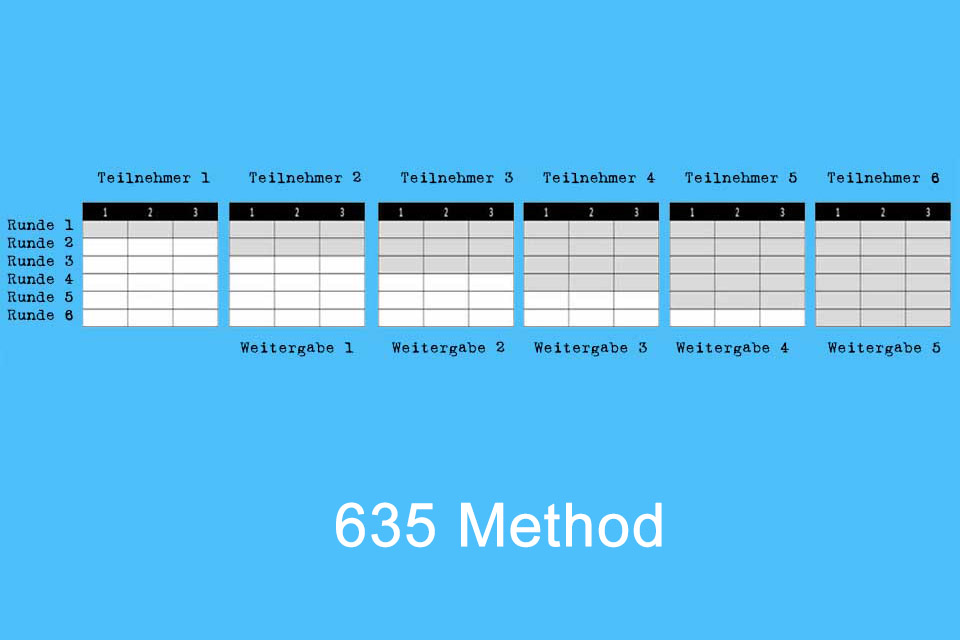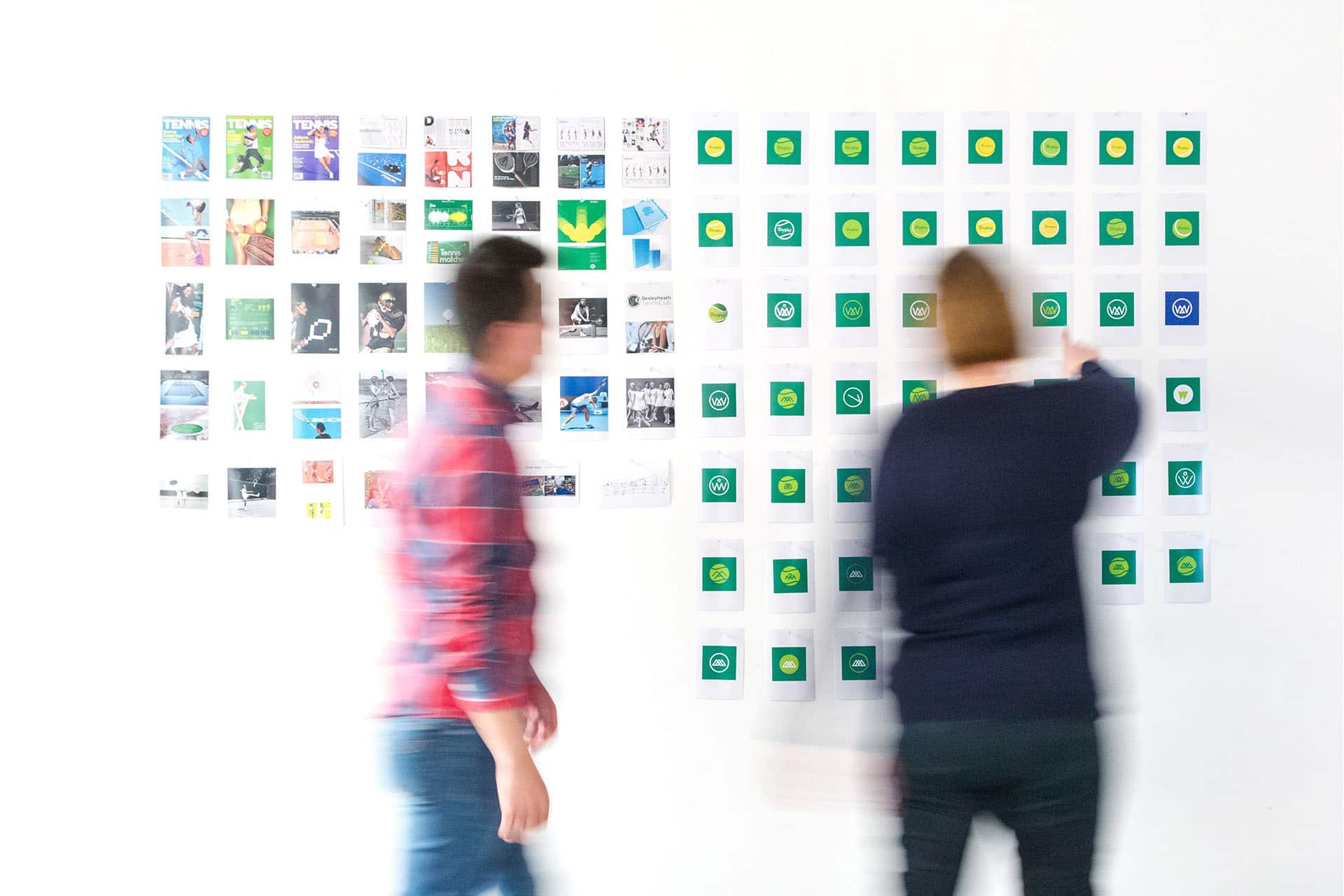What is the 635 Method?
Smartpedia: The 635 Method is a creativity technique in which 6 participants note 3 ideas each, which are supplemented by 3 new ideas in 5 alternations.
635 Method – collaborative creative via brainwriting
The 635 method is the best known variant of brainwriting. Brainwriting is about the development of ideas in a team and in contrast to brainstorming, probably the best known creativity technique, finding ideas is done in writing and thus non-verbally.
The 635 method – also known as method 635 or 6-3-5 method or 635 for short – was designed by Bernd Rohrbach, a German management consultant, in 1986. 6 participants each develop 3 ideas in 5 changes – hence the name of the 635 method. In this way, up to 108 documented ideas are created, which are then discussed, grouped and evaluated together.
The procedure for the 6-3-5 method
The setting for the 6-3-5 method is relatively simple:
- Each of the six participants receives a prepared sheet with the task and six rows with three columns each, i.e. 18 fields.
- In the first round, each participant notes up to a maximum of three ideas in the top row in a predetermined time. Since creativity doesn’t work at the push of a button, it’s no big deal if less than three ideas come together.
- After the first and each subsequent round, the sheets continue to rotate clockwise until one’s own sheet is in front of one again. For each round, three new or complementary ideas are noted in the next line.
In practice, the use of pools – the shuffling of sheets in the middle of the table – is often practiced instead of the rotation of sheets. The anonymity of the ideas and thus the freedom of thought is maximised in the “brainwriting pool”.
Advantages and disadvantages of the 6-3-5 method
The 6-3-5 method as a brainwriting variant offers some advantages, but it is also not free of disadvantages.
The advantages include:
- A lot of ideas are gained in a relatively short time.
- The ideas – at least when they are collected – are not talked to pieces.
- There is a natural documentation, as well as a kind of protocol with the development of the ideas.
- None of the participants can dominate the collection of ideas – at least if the rules are respected. In other words, even introverts can document their ideas.
Some publications say that participants cannot “sit back” because they are challenged every round; but this is not correct, because of course participants are neither forced nor can ideas be found at the push of a button.
The disadvantages include:
- In the course of collecting ideas, there is no opportunity for queries.
- Creativity is often not easy to switch on (and also not to switch off), but the usual process requires this in a certain way.
- The given pace of work can possibly lead to fewer ideas being collected overall, as some participants are “too slow”.
- The format can also lead to the fact that not all ideas are collected from participants, as they are “only” allowed to collect three ideas per round.
- Since there is no matching (in conjunction with the timebox per round), redundancies can easily occur.
And last but not least: The 6-3-5 method, like any other brainwriting approach, does ensure that even introverts can capture ideas, but often these also need a certain lead-in. It is therefore a good idea to communicate the topic in advance (see tips). And in the course of the subsequent discussion, the more extroverted participants may again be favoured; in such a case, the moderator would of course be called upon to ensure an appropriate balance of the speaking shares of all participants.
Tips for the 635 Method
There are a number of tips that are useful when using the 635 method:
- The template for the documentation should be uniformly designed / duplicated.
- No one should write down their name on the sheets. Ideally, this is an anonymous method. Of course it can happen that the participants know each other well and can assign the different writing styles to individual colleagues. Nevertheless, the aim is to find ideas together and evaluate them independently of the author.
- Uniform pens with identical colours should be used.
- In later rounds, finding ideas may take a little longer than at the beginning of brainwriting. Here it is up to the moderator to provide a little more time.
- And for introverts, it can be useful if they learn about the problem to be solved some time in advance so that they can think about the solution early on.
Opinions differ as to whether additional sheets should also be made available for further ideas. The pro-argument is: the more ideas, the better. The contra-argument is: If an idea does not make it into one’s own “Top 18” (6 rounds with 3 ideas per person), then the idea is not worth dealing with. It is important to discuss an appropriate procedure from the beginning. If further ideas arise in a joint exchange after the 6 rounds, they are usually included in the assessment.
Download the Ideation Whitepaper for free now.
Everything important about Ideation at a glance.
- Definition and tips from practice
- Idea evaluation
- Methods such as reverse and round robin brainstorming, headstand technique, scamper, starbursting, brainwriting, braindumping, Osborn checklist or 1-2-4-All in detail
Knowledge on 17 pages to take away.
Could it be useful to ask different questions on each worksheet?
Notes:
Here you can find a German-language video about the 6-3-5 method as a creativity technique for finding ideas.
If you like the article or would like to discuss it, please feel free to share it in your network. And if you have any comments, please do not hesitate to send us a message.
Here you can find additional information from the t2informatik Blog:




